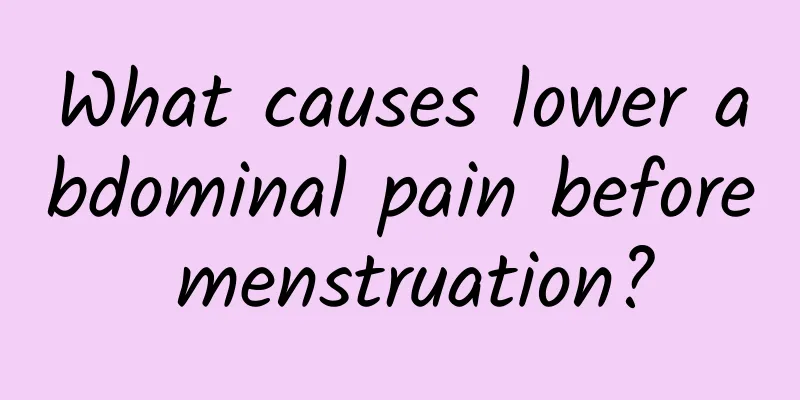What causes lower abdominal pain before menstruation?

|
Lower abdominal pain before menstruation is often related to factors such as uterine contraction pain, premenstrual syndrome, endometriosis, adenomyosis, etc. Understanding these causes can help you better cope with and manage symptoms. 1. Uterine contraction pain: When menstruation comes, the level of prostaglandins in the body increases, causing excessive contraction of uterine smooth muscle and vascular contraction. This physiological change may cause lower abdominal pain and back pain. In most cases, this pain is tolerable. Keeping the abdomen warm and relaxing can help relieve it to a certain extent. If the pain is unbearable, you can use drugs such as ibuprofen under the guidance of a doctor. 2. Premenstrual syndrome: This problem involves hormonal changes and psychological factors. Women may feel lower abdominal pain, mood swings, breast tenderness, etc. during the luteal phase before menstruation. Although these symptoms usually subside on their own after the end of menstruation, the discomfort can be reduced through proper exercise and healthy diet in daily life. 3. Endometriosis: This is a disease caused by the growth of endometrial tissue outside the uterus, often accompanied by dysmenorrhea and irregular menstruation. The symptoms of dysmenorrhea will gradually worsen over time. If you find that dysmenorrhea is becoming more and more severe, it is recommended to seek medical attention and treatment in time. 4. Adenomyosis: The exact cause of this disease is still unclear, but it may be related to the invasion of the endometrium into the myometrium. Patients usually begin to feel lower abdominal pain a week before menstruation, and this pain may worsen over time. Increased menstrual flow is also a common symptom. 5. Other possible causes: In addition to the common causes mentioned above, lower abdominal pain may also be caused by other health problems, such as ectopic pregnancy, ovarian or fallopian tube tumors, cholecystitis, etc. If the symptoms persist or worsen, it is recommended to see a doctor for professional evaluation as soon as possible. In daily life, a proper diet and appropriate exercise can help relieve premenstrual discomfort. You can try to reduce caffeine and salt intake and increase foods rich in magnesium and calcium, such as nuts and green leafy vegetables. Relaxation exercises such as yoga and meditation can also help reduce stress and pain. Understanding your own physical condition, seeking medical treatment in time and taking appropriate measures are the keys to managing and improving premenstrual lower abdominal pain. |
<<: The dangers of taking emergency contraceptive pills right after menstruation
>>: What are the symptoms and phenomena of cervical erosion, and what medicine should I take?
Recommend
What are the symptoms of vulvar leukoplakia?
Vulvar leukoplakia is also known as vulvar white ...
Is it dangerous to have a painless abortion for a scarred uterus? Can I still get pregnant?
There are certain risks in painless abortion for ...
What are the precautions for recurrent miscarriage? Pay attention to these 3 points
Women with recurrent miscarriage should pay atten...
Do you know what to pay attention to before treatment of pelvic inflammatory disease?
Have you ever paid attention to the precautions b...
Eat three kinds of food when ovarian function declines
The ovaries are very important reproductive organ...
The dangers of threatened miscarriage in the first pregnancy
Pregnancy is the most important event in a woman&...
Is it normal for grass jelly to be thick? Nutritionist says...
When the weather is cold, there is nothing more s...
How long does it take to cure pelvic inflammatory disease?
Pelvic inflammatory disease is a disease that is ...
3-day tips to relieve headaches without medication
According to the World Health Organization, more ...
Let's learn about the harm of dysmenorrhea
Dysmenorrhea is not unfamiliar to many women, but...
Four main tests for cervical hypertrophy
Clinically, the best way to check for cervical hy...
Two main causes of irregular menstruation
Women will feel uncomfortable before and after me...
Obesity, loss of appetite…beware of these 5 hidden symptoms of pancreatic cancer!
Pancreatic cancer is a silent killer. As its symp...
Zheng Duoyan: I didn't get fat and recommended a 7-meal-a-day diet
Zheng Da Yan, who is famous in Asia for her uniqu...
How to cure severe cervical erosion in women? Try these methods to cure severe cervical erosion
Many women have some gynecological diseases when ...









